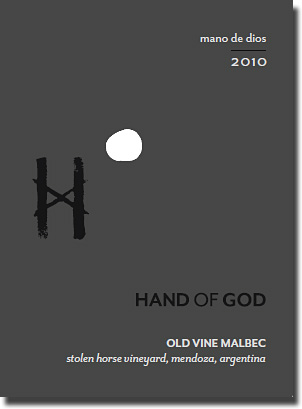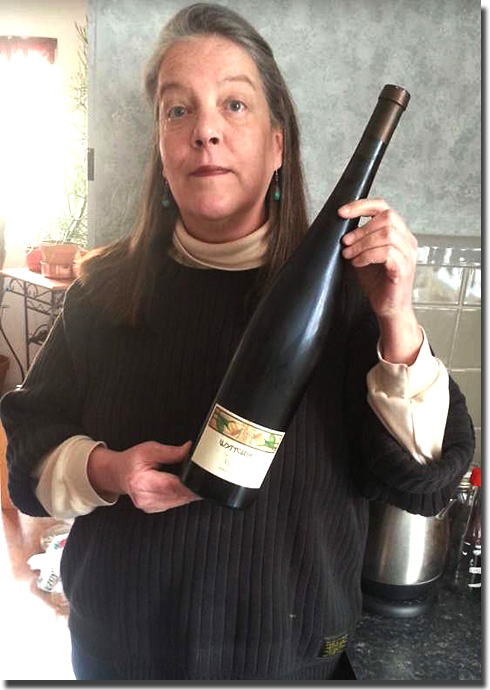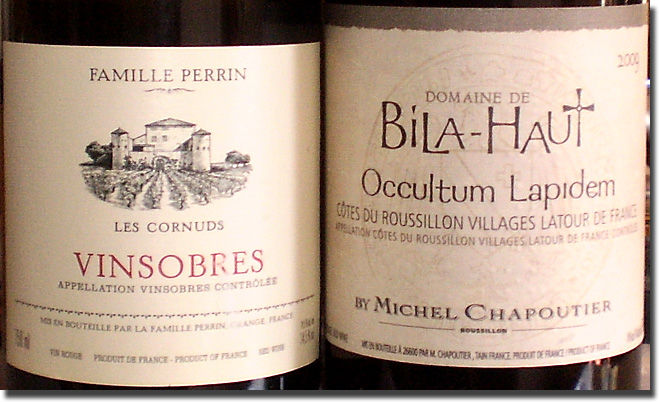Archive for April, 2013
Two from Hand of God
 Since our first serious encounter with Argentine wine back in 2003, I’ve maintained the somewhat tongue-in-cheek, but perfectly arguable stance that beef and Malbec are the unofficial national food and drink of that country. The two complement each other about as well as any pairing one might imagine, as we’ve seen (and tasted) again and again in the ensuing years.
Since our first serious encounter with Argentine wine back in 2003, I’ve maintained the somewhat tongue-in-cheek, but perfectly arguable stance that beef and Malbec are the unofficial national food and drink of that country. The two complement each other about as well as any pairing one might imagine, as we’ve seen (and tasted) again and again in the ensuing years.
We rarely eat beef anymore, because of our changing dietary habits. We avoid giving any support to factory farms, for health, environmental and animal cruelty concerns, and when we do consume the flesh of four-footed mammals, it’s usually in the form of Kim’s pork projects or pasture-raised, grass fed lamb.
We also don’t drink much wine from Argentina these days, either, not because they aren’t making high-quality juice down there, but for the same money, or less, our preferences come from southern France. Mostly different grape varieties, true, but those are what we like, and we tend to stick with them. Still, we are always happy to see what they’re producing in South America when we get the chance, and such was the case a few weeks ago.
We’d never heard of Hand of God Wines before we tried these two, but it’s obvious that they have some seriously good things going for them. Hand of God is a collaboration between American venture-capital entrepreneur Jon Staenberg and Argentine winemaker Santiago Achával, better known for his highly acclaimed Achaval-Ferrer winery in Mendoza. The two selections we sampled for review were sourced from the two estate vineyards, Stolen Horse Vineyard, planted in the 1920s in the Cruz de Piedra area of the Maipú region, and Sobremesa Vineyard, established in 2007 in Valle de Uco. Stolen Horse consists of 8 acres of old vine Malbec, while Sobremesa is planted to more than 47 acres of Malbec, Merlot, Cabernet Franc, Viognier, Roussanne, Marsanne and Sauvignon Blanc. (A white blend of 35% Viognier, 35% Marsanne and 30% Roussanne, 2011 Fingerprint Series Único, is yet to be released.) Both the new and the old world techniques are used to produce the wines; the vineyards are still plowed by horse, even though tractors could do the job more quickly.
Read the rest of this entry »
Tasty Wines from Bonny Doon
 We’ve been fans of Bonny Doon wines since well before I interviewed head honcho Randall Grahm back in 2005, so much so, that we’ve kept track of what they’re producing over the ensuing years and reported accordingly on several occasions. (The cyber-trail going backwards starts here.) I’ve even gone so far as to write Bonny Doon into one of my songs, “I’m Getting’ Squirrelly in My Old Age,” so we were quite geeked when we received a box containing several of the Doon’s recent releases not long ago, including some things not available through normal retail outlets. Read on for the full rundown on our impressions, starting with a couple of nice whites, and including pertinent comments by Randall following each note.
We’ve been fans of Bonny Doon wines since well before I interviewed head honcho Randall Grahm back in 2005, so much so, that we’ve kept track of what they’re producing over the ensuing years and reported accordingly on several occasions. (The cyber-trail going backwards starts here.) I’ve even gone so far as to write Bonny Doon into one of my songs, “I’m Getting’ Squirrelly in My Old Age,” so we were quite geeked when we received a box containing several of the Doon’s recent releases not long ago, including some things not available through normal retail outlets. Read on for the full rundown on our impressions, starting with a couple of nice whites, and including pertinent comments by Randall following each note.
2011 Bonny Doon Le Cigare Blanc Arroyo Seco “Beeswax Vineyard,” 62% Grenache Blanc, 38% Roussanne, 12.5% alc., $28: Clean, medium color; white peach and mineral nose carries over nicely onto the palate, where the minerality takes on a slightly chalky character. Full bodied, with good acids and length. As mentioned in the accompanying notes from BD, this is a food wine, rather than an easy sipper, and indeed, it pairs nicely with lightly braised chicken thighs and onions, a brown rice/beluga lentil medley and steamed broccoli. It seems somewhat muted when tasted alongside the ’10 Réserve, which is perhaps an unfair comparison. Considered on its own terms, it’s a solid white that will get better with some years in the bottle. 1650 cases produced. Find this wine
RG: “Another cool vintage with a blessedly low degree of alcohol (12.5%), much as we had observed in 2010.”
2004 Wyncroft Riesling Madron Lake
 Our good friends Kris Engelhardt and Kathy Bunting let it be known that they were on their way over with raw oysters yesterday, and it occurred to me that it would be the perfect opportunity to open the magnum of Wyncroft Riesling that had been resting in our cellar for some years. The wine was a gift from another good friend, Mr. Wyncroft himself, Jim Lester, and it turned out to make a perfect match for the wonderful Kumamoto oysters.
Our good friends Kris Engelhardt and Kathy Bunting let it be known that they were on their way over with raw oysters yesterday, and it occurred to me that it would be the perfect opportunity to open the magnum of Wyncroft Riesling that had been resting in our cellar for some years. The wine was a gift from another good friend, Mr. Wyncroft himself, Jim Lester, and it turned out to make a perfect match for the wonderful Kumamoto oysters.
2004 Wyncroft Lake Michigan Shore Riesling Madron Lake Vineyard, 1.5 L, 13% alc.: It’s interesting to compare yesterday’s impressions of this wine with those from 2006, when we first tried it, shortly after it was bottled. Back then, it was quite primary, as one might expect, with subtle minerality taking a backseat to the upfront fruit. The intervening time has been very kind (and the 1.5 liter format didn’t hurt either), as it has developed into a thing of beauty, reminiscent of Jim’s great 1999 Wyncroft Lake Michigan Shore Riesling Avonlea Vineyard. Like a hypothetical cross between Riesling from Alsace and Austria, this is now all about river stones and petrol over under-ripe green apple and quince. Medium-full-bodied, it still exhibits excellent acids and good length on the finish. I can’t think of a better example of just how good dry Riesling from Michigan can be. Find this wine
Reporting from Day-twah,
geo t.
More Red Wings and Red Rhônes 2013
 The Red Wings and Red Rhônes revival continued this past week, when the boys wearing the winged wheel on their jerseys returned to the west coast for a four game swing. These two wines paired well with consecutive wins over the Anaheim Ducks and Phoenix Coyotes.
The Red Wings and Red Rhônes revival continued this past week, when the boys wearing the winged wheel on their jerseys returned to the west coast for a four game swing. These two wines paired well with consecutive wins over the Anaheim Ducks and Phoenix Coyotes.
I’ve never been a big fan of the wines of M. Chapoutier. Some I’ve tried have been very good, and more have been not so great. The Bila-Haut bottlings I’ve had in the past have been decent, however, so there didn’t seem to be too much risk involved with trying this one, especially at the Costco price.
Read the rest of this entry »



